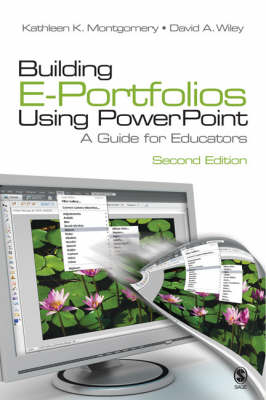
Building E-Portfolios Using PowerPoint
SAGE Publications Inc (Verlag)
978-1-4129-5675-8 (ISBN)
A systematic approach toward creating a compelling electronic portfolio
New to the Second Edition
Expands coverage on planning and managing the development of an e-portfolio
Addresses the National Educational Technology Standards (NETS)
Presents new content on integrating PowerPoint with the Internet, as well as other applications
Incorporates "Questions to Guide E-Portfolio Preparation" at the end of each chapter
Provides notes on using PowerPoint 2007
Focuses on the future of e-portfolios in a revised chapter
Includes a troubleshooting section
Also included
This up-to-date guide includes a CD featuring several examples of e-portfolios, as well as a useful template.
Intended Audience
Designed for preservice and inservice teachers, this practical resource is essential for professional educator preparation.
Kathleen Montgomery is an Associate Professor in the Education Department at The University of Scranton. She is an elementary education generalist who has taught grades K-8 for sixteen years in the United States as well as in International Schools. She served as the Director of Undergraduate Programs at The University of Scranton and has authored numerous articles and a book on alternative assessment methods, including portfolio assessment. David A. Wiley is a Professor in the Education Department at the University of Scranton in Scranton PA. After teaching science for more than fourteen years, he moved to the University in 1988. He has served as Department Chair for over nine years, is now serving as Certification Officer, and was a co-author of the assessment plan used with teacher candidates at the University of Scranton. His research interests include mathematics and science education, technology education, and teacher effectiveness in the classroom setting. He has authored more than forty articles and three previous books in his areas of expertise. He has presented at the Pennsylvania and the National Science Teachers Associations, at the American Association of Colleges of Teacher Education, and meetings of many other organizations. His service agenda is heavy in the area of teacher preparation and working with science teacher professional associations. Dr. Wiley is married, the father of a son and three daughters, and lives in Clarks Summit, PA where, in his spare time, he volunteers with the Clarks Summit Fire Company.
Part I: Assessment and the Use of Electronic Portfolios
Chapter 1: The Foundations for Portfolio Development
Introduction
Terms Used in Portfolio Development
The Advantages and Disadvantages of Portfolio Assessment
The Performance-Based Movement
Reflection: An Integral Part of Portfolio Development
The Power of Portfolios
Summary
Chapter 2: Kinds of Portfolios and Their Uses
Introduction
Types of Portfolios
Planning for a Portfolio
Examples From Purposeful Portfolios
Summary
Chapter 3: Using Standards in Portfolio Construction
Introduction
Standards for Teachers
Resources for Standards
Summary
Chapter 4: Self-Assessment Through Reflection
Introduction
Rubrics Can Help
Reflection and Self-Assessment
Self-Assessment for Teachers
Self-Assessment Opportunities for Students
Summary
Chapter 5: Presenting the Portfolio
Introduction
Presentation Skills
Additional Resources for Design Decisions
Presenting the Portfolio to Others
Presentation of Teacher Portfolios
Presentations of Student Portfolios
Professional Development Presentations
Summary
Part II: Using PowerPoint to Author E-Portfolios
Chapter 6: Options for Electronic Portfolios
Introduction
Web-Based E-Portfolio Tools
Non-Web-Based (Local) E-Portfolio Tools
Selecting a Portfolio Tool
PowerPoint as an E-Portfolio Development Tool
Summary
Chapter 7: PowerPoint Basics
Introduction
Start at the Beginning
Starting PowerPoint
Selecting a Slide Background
Selection of Font Type and Size
Selecting Slide Views to Accomplish Work
A Word About Copyright Law
Is There Fair Use?
Adding Clip Art to the Presentation
Adding Internet Images to the Presentation
Adding Sound to the Presentation
Adding Movies to a Presentation
Adding Internet or Document Links to the Presentation
Using Action Buttons
Showing the Presentation
Summary
Chapter 8: Building Nonlinear PowerPoint Portfolios
Introduction
Making PowerPoint Less Linear by Hyperlinking
Building a Structure for an Electronic Portfolio
Editing Images Using Basic Photoshop Elements Capabilities
Editing Sound
Editing Video
Summary
Chapter 9: Tools You Can Use
Introduction
Collecting Documents for the Portfolio
Of Dots and Pixels: Image Sizes
Scanning Materials for Use as Artifacts
Using Digital Cameras to Capture Images
A Few Photography Hints
Capturing and Using Digital Video
Saving a Portfolio to Media
Burning a CD
Saving Information to a DVD
Summary
Chapter 10: Special Considerations and Options
Introduction
Planning an E-Portfolio
What Happened? A Guide to Common Technical Errors
Downloading Required Programs--For Free
Downloading QuickTime--For Free
The Top Ten List
Moving a PowerPoint Presentation to the Web
The Future: What Promises to Make Electronic Portfolios More Effective?
Summary
Appendix: Troubleshooting Your PowerPoint-Based E-Portfolio
| Erscheint lt. Verlag | 22.4.2008 |
|---|---|
| Verlagsort | Thousand Oaks |
| Sprache | englisch |
| Maße | 152 x 228 mm |
| Gewicht | 340 g |
| Themenwelt | Sozialwissenschaften ► Pädagogik ► Allgemeines / Lexika |
| Sozialwissenschaften ► Pädagogik ► Bildungstheorie | |
| ISBN-10 | 1-4129-5675-7 / 1412956757 |
| ISBN-13 | 978-1-4129-5675-8 / 9781412956758 |
| Zustand | Neuware |
| Haben Sie eine Frage zum Produkt? |
aus dem Bereich


